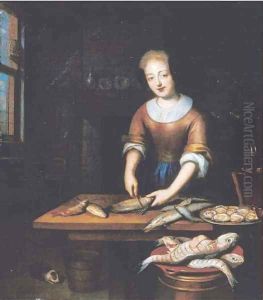Reynier De La Haye Paintings
Reynier de la Haye, also known as Reinier de la Haye, was a Dutch painter born in 1640 in The Hague. His early life and training as an artist remain relatively undocumented, but he is believed to have been a pupil of the Dutch Golden Age painter Joris van der Haagen, who was known for his landscapes and inspired many artists of the era.
De la Haye's body of work largely consists of landscapes, often depicting forest scenes, dunes, and rural areas, reflecting the traditional Dutch landscape style of the 17th century. His paintings were notable for their naturalistic detail and the use of light, which he manipulated to enhance the mood and depth of his scenes. He worked in a period that was heavily influenced by the tonal landscape painters, who emphasized atmospheric effects in their works.
While Reynier de la Haye is not as widely known as some of his contemporaries, such as Jacob van Ruisdael or Meindert Hobbema, he contributed to the rich tapestry of Dutch landscape painting. His works were appreciated for their serenity and the artist's skill in capturing the tranquil essence of the Dutch countryside.
De la Haye's career unfolded primarily in The Hague, where he became a member of the painter's confraternity, the Confrerie Pictura, an important institution for artists in the city. The Confrerie Pictura was established as an alternative to the traditional guild system and it played a crucial role in the artistic life of The Hague during the 17th century.
Reynier de la Haye remained active until his death in 1695. Unfortunately, like many artists of his time, his name fell into relative obscurity, and much of his work was either lost or attributed to other artists. Despite this, some of his landscapes have survived and can be found in art collections and museums, allowing a glimpse into the pastoral world that de la Haye captured with his brush.
